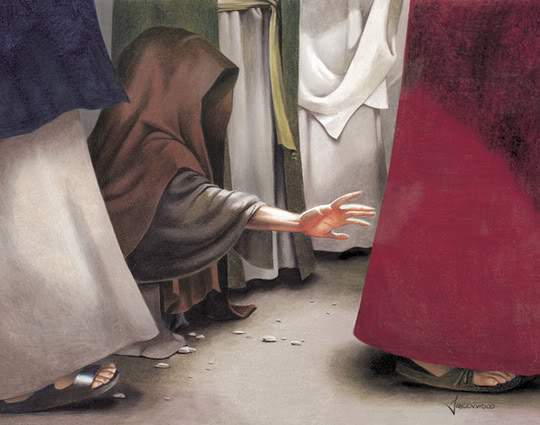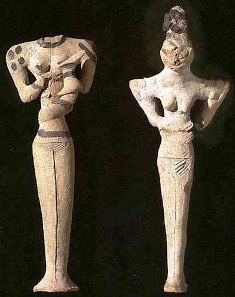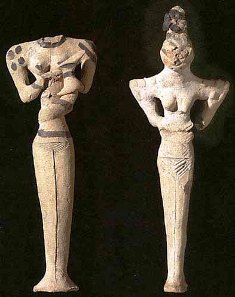Menstruation: what did the Bible teach?
How did this affect women’s lives?
 The biblical law states when a woman menstruates she is unclean for seven days. The text says that
The biblical law states when a woman menstruates she is unclean for seven days. The text says that
‘whoever touches her shall be unclean until the evening.
And everything upon which she lies during her impurity shall be unclean; everything also upon which she sits shall be unclean.
And whoever touches her bed shall wash his clothes, and bathe himself in water, and be unclean until the evening.

The woman reaches up towards Jesus,
reluctant to touch him
And whoever touches anything upon which she sits shall wash his clothes, and bathe himself in water, and shall be unclean until the evening; whether it is the bed or anything upon which she sits, when he touches it he shall be unclean until the evening.
And if any man lies with her, and her impurity is on him, he be unclean seven days; and every bed on which he lies shall be unclean.’ (Leviticus 15.19-24)
Note especially:
A Bible law that governed the life of the menstruating woman cured by Jesus:
If a woman has a discharge of blood for many days, not at the time of her impurity, or if she has a discharge beyond the time of her impurity, all the days of the discharge she shall continue in uncleaness; as in the days of her impurity, she shall be unclean. (Leviticus 15:25)
Were the regulations good or bad?
These basic regulations seem harsh/impractical to a modern woman who does not allow herself, or cannot afford, time out during her period of menstruation.
But the ancient regulations created time out for women, periods of separation away from their husbands and other male members of family and community.
Of course the regulations divided the community by gender, but menstruating women themselves formed a community for the period of menstruation, and at the end of their seven days they went together to the pool for ritual bathing.
What was the effect of this law?
In the ancient Jewish world, this practice meant that sexual intercourse only took place at a time in the monthly cycle when a woman was most likely to conceive.

The menstruating woman reaches out to touch the hem of Jesus’ robe
Menstruation and impurity
Jennie Ebeling writes about it in her book ‘Women’s Lives in Biblical Times’:
‘Although the Hebrew Bible does not provide many details about the reality of menstruation, Leviticus 15 relates that regular and abnormal female genital discharge was considered unclean and that menstruating women were restricted from participating in public religious activity during that time (Lev. 15.18-33.
Specifically, menstruation resulted in a seven-day period of impurity when a woman could not enter the sanctuary. The menstruating woman and the objects under her could transfer impurity, and anyone who touched her or these objects would experience a period of impurity and would be compelled to wash themselves and their clothes. If a man engaged in intercourse with a menstruating woman he was either impure for seven days (Leviticus 15.24) or cut off from his people, along with the woman (Leviticus 20.18).
Bible stories about menstruation
There are other references to menstruation in the Hebrew Bible, notably two stories in Genesis:
- where the text relates that “it had ceased to be with Sarah (wife of Abraham) after the manner of women” (Genesis 18.11) and
- in Genesis 31.34-35, the story of Rachel’s theft of her father’s teraphim.

Figurines from Ur in southern Mesopotamia, circa 4000BC, probably similar to terephim hidden by Rachel
Rachel’s story provides some interesting information about the reality of female menstruation in the context of the ancient Israelite household. In this passage, after Rachel steals her father Laban’s teraphim — household gods — and sits on them to hide them, she matter-of-factly tells her father that she cannot stand up when he enters the tent to search for them because “the way of women is upon me” (Genesis 31.35).
This passage might reflect a small, tight social group in which everybody knew which of the women menstruated, and when, and it was perhaps not at all unusual for household members to discuss female menstruation.
In addition, Laban did not find Rachel’s reason for not standing up unusual or suspicious, so it may have been considered normal for a menstruating woman to be seated more than usual…
Although no archaeological evidence for them has been identified, the menstrual cloth (beged idim) is mentioned in Isaiah 64.6. Menstruation is used as an image of impurity elsewhere in Isaiah (30.22) and in Lamentations, where a woman with unclean (bloody) skirts (Lamentations 1.9) serves as a metaphor for Jerusalem after its destruction.
Quoted from Jennie Ebeling, ‘Women’s Lives in Biblical Times, T. & T. Clark International, 2010
For additional information on the lives of women in the Bible, see
Family, work and religion : the tribe, the family, slaves, women’s tasks, beliefs
Stages of a woman’s life: Puberty, menstruation, marriage, childbirth, death, burials
Save
Search Box
![]()

Painting from the catacombs: the story of the woman with an issue of blood was important to the earliest Christians
Other miracles of Jesus
© Copyright 2006
Elizabeth Fletcher













